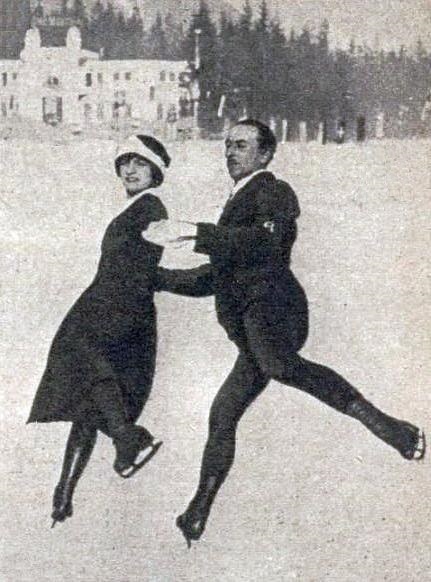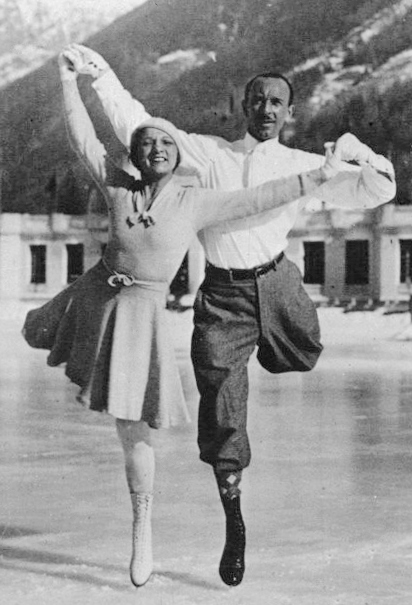1. Overview
Andrée Marguerite Blanche Brunet (born Andrée JolyAndrée JolyFrench) was a pioneering French figure skater who significantly influenced the sport, particularly in pair skating. Alongside her husband, Pierre Brunet, she achieved remarkable success, securing Olympic medals in 1924, 1928, and 1932, including two gold medals. They also earned four World Championship titles between 1926 and 1932. Brunet was also a formidable singles skater, winning multiple national titles and competing in two Olympic Games. After retiring from competitive skating, she transitioned to a professional career and became a highly respected coach in the United States, training future Olympic champions. Her contributions to figure skating were recognized with her induction into the World Figure Skating Hall of Fame.
2. Personal Life
Andrée Marguerite Blanche Brunet was born Andrée JolyAndrée JolyFrench on September 16, 1901, in Paris, France. She was known by her maiden name, Andrée Joly, until her marriage. In 1927, she married her skating partner, Pierre Brunet, and subsequently competed under her married name, Andrée BrunetAndrée BrunetFrench. She stood 65 in (165 cm) tall.
2.1. Children
Andrée and Pierre Brunet had a son named Jean-Pierre Brunet, who also pursued a career in figure skating. Jean-Pierre became a notable competitor, winning the U.S. pairs championship in both 1945 and 1946 with his partner, Donna Jeanne Pospisil.
3. Skating Career
Andrée Brunet's skating career was marked by innovation and dominance in both singles and, most notably, pair skating. She and Pierre Brunet are widely credited with revolutionizing pair skating by introducing groundbreaking techniques and elements that transformed the sport. Their style, which became common among other skaters, included the development of mirror skating, new types of jumps, intricate lifts, and innovative spins. At their first Olympic appearance in 1924, they showcased more complex skills than any previous pair, though judges initially penalized them for performing "too many tricks," awarding them a bronze medal. Andrée Joly was also among the first female skaters to wear a black dress that matched her partner's outfit, departing from the traditional white dress.

3.1. Singles Skating
Andrée Brunet competed successfully in ladies' singles events throughout her career. She was a dominant force in French national competitions, winning the French national title in singles for ten consecutive years, from 1921 to 1930. She also represented France in singles at the Winter Olympic Games. At the 1924 Winter Olympics, she finished in fifth place. Four years later, at the 1928 Winter Olympics, she placed eleventh in the singles competition.
3.2. Pair Skating
Andrée Brunet's most significant achievements came in pair skating, where she formed a legendary partnership with Pierre Brunet. Their collaboration led to the development of several pioneering techniques, including mirror skating, where both partners perform identical movements simultaneously. They introduced new types of jumps, lifts, and spins that were previously unseen in the discipline, fundamentally changing the dynamics and complexity of pair skating. This innovative approach earned them the reputation of having "changed the history of pairs" figure skating. Their unique style and advanced repertoire set new standards for the sport and influenced subsequent generations of skaters.

3.3. Major Competitions
Andrée Brunet and Pierre Brunet were the first French skaters to win gold medals at World, European, and Olympic competitions. After securing a silver medal at the 1925 World Championships in a contest described as "one of the closest contests in pair skating history," they achieved an unparalleled winning streak, claiming every competition they entered thereafter.
3.3.1. Olympic Games
Andrée Brunet participated in three Winter Olympic Games, competing in both pairs and singles events.
- 1924 Chamonix:
- Pairs: Bronze medal
- Ladies' Singles: 5th place
- 1928 St. Moritz:
- Pairs: Gold medal
- Ladies' Singles: 11th place
- 1932 Lake Placid:
- Pairs: Gold medal
3.3.2. World Championships
Andrée Brunet and Pierre Brunet achieved significant success at the World Figure Skating Championships in the pairs discipline.
| Event | 1925 | 1926 | 1928 | 1930 | 1932 |
|---|---|---|---|---|---|
| World Championships | 2nd | 1st | 1st | 1st | 1st |
3.3.3. European Championships
Andrée Brunet and Pierre Brunet also competed in the European Figure Skating Championships, where they continued their winning ways in pairs.
| Event | 1932 |
|---|---|
| European Championships | 1st |
3.3.4. French Championships
Andrée Brunet was a dominant figure in French national figure skating, winning multiple titles in both singles and pairs.
| Event | 1921 | 1922 | 1923 | 1924 | 1925 | 1926 | 1927 | 1928 | 1929 | 1930 | 1931 | 1932 | 1933 | 1934 | 1935 |
|---|---|---|---|---|---|---|---|---|---|---|---|---|---|---|---|
| French Championships (Ladies' Singles) | 1st | 1st | 1st | 1st | 1st | 1st | 1st | 1st | 1st | 1st | |||||
| French Championships (Pairs) | 1st | 1st | 1st | 1st | 1st | 1st | 1st | 1st | 1st | 1st | 1st |
3.4. 1936 Olympic Participation
Despite their continued success and dominance in French figure skating, Andrée and Pierre Brunet made a significant decision not to participate in the 1936 Winter Olympics held in Garmisch-Partenkirchen, Germany. Their non-participation was a principled protest against the Nazi regime that was in power in Germany at the time. This decision reflected their stance against the political climate and human rights issues associated with the Nazi government.
4. Post-Retirement Activities
Andrée Brunet and Pierre Brunet retired from competitive skating in 1936. Following their competitive careers, they transitioned into professional ice shows, touring extensively across Europe and Canada. In 1940, the couple emigrated to New York, United States, establishing a new phase of their careers.
4.1. Coaching Career
After settling in the United States, Andrée and Pierre Brunet embarked on highly successful coaching careers. They became renowned figure skating coaches, working in various locations including New York, Illinois, and Michigan. Their expertise and guidance helped shape the careers of several prominent skaters, including future Olympic champions. Notably, they coached Carol Heiss, who won a gold medal at the 1960 Winter Olympics, and Scott Hamilton, who earned a gold medal at the 1984 Winter Olympics. They continued to coach until their retirement in 1979.
5. Honors and Awards
Andrée Brunet's significant contributions to the sport of figure skating were formally recognized through prestigious honors and awards.
5.1. World Figure Skating Hall of Fame
In 1976, Andrée Brunet, along with Pierre Brunet, was inducted into the World Figure Skating Hall of Fame. They were part of the inaugural class of inductees, a testament to their pioneering spirit and lasting impact on figure skating.
6. Death
Andrée Brunet died on March 30, 1993, at the age of 91, in Boyne City, Michigan, United States.